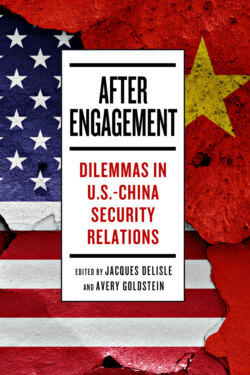Читать книгу After Engagement - Группа авторов - Страница 15
PROSPECTS FOR US-CHINA RELATIONS
ОглавлениеGiven the array of factors that have contributed to the deterioration in US-China relations since the late 2000s, it seems unlikely that there will be a swift return to a pragmatic, managed competition that focuses significantly on mutual benefits, much less the more optimistic scenarios for cooperation and convergence that were a big part of the discourse during the four decades following normalization. But that does not mean the United States and China are destined to reprise the Cold War rivalry between the United States and the Soviet Union, much less go to war with one another, directly or through proxies.
Warfighting remains unlikely, in part because nuclear-armed superpowers face unacceptably dire consequences that deter them from direct military conflict over even fundamentally conflicting interests and values.65 Several factors continue to distinguish the current troubled US-China relationship from former US-Soviet relations and weigh against a new Cold War. Restraint is in the self-interest of both the United States and China because of the obvious benefits each can derive from the following: an open, rules-based, international economic order; negotiating limitations on a potentially costly arms race that would do little to enhance security when each side already has a nuclear deterrent that provides a robust buffer against existential military threats; and cooperating on global issues for which the United States and China are pivotal actors with big stakes (such as climate change and the recurrent challenges of global public health emergencies). Unless the costly process of decoupling goes much further than currently seems likely, the economic connections that long have underpinned bilateral ties will continue to give both sides large material incentives to avoid a reprise of the Cold War division into two largely walled-off camps.
Despite recent trends in the domestic politics of foreign policy in both countries that favor a tougher line toward the other side, still-influential actors and constituencies in both polities are wary of the consequences of further deterioration of bilateral relations. Although the consensus in Washington supporting constructive engagement has crumbled, there is no incipient new consensus that sees a new Cold War as inevitable, much less desirable. Ideational conflict is not destined to move rapidly beyond its current, inchoate state. The US’s always-fitful emphasis on values issues in US-China relations, which has been in relative eclipse for most of the past decade, has been rising and the Biden administration embraces this emphasis without the equivocation sometimes evident under Trump. Whether this trend will make disputes over values central to the US’s China policy is unclear. And despite the Xi-era turn to promoting a Chinese model and an international “community of common destiny,” Beijing is not yet on the verge of offering, or pressing for, something akin to the rival ideology championed by the Soviet Union in its struggles with the United States during the Cold War era.66
But objectively strong reasons to moderate hostility may not be enough, and the differences between current US-China relations and those of the Cold War superpowers may diminish. Arresting, let alone unwinding, the downward spiral into deepening rivalry will be difficult. Both countries are likely to remain acutely sensitive to relative rather than absolute gains that affect the risks each confronts and the threats each perceives. To avoid falling behind in a competitive relationship, and to hedge against the remote but highly consequential possibility of armed conflict between nuclear powers, the US and China are likely to invest heavily in military capabilities, increasing the severity of the security dilemma each perceives. If economic decoupling—reinforced by the growing securitization of many issues in US-China relations and accelerated by lessons drawn from the COVID-19 pandemic about the risks of import-dependence—weakens or severs global supply chains that have linked China and the United States, other states will face greater pressure to choose a side in a world that is not only bipolar but also divided once more into rival camps. The “get tougher” politics of US policy toward China seems likely to constrain political leaders from both parties.
Although the Biden administration’s approach to China policy differs from its predecessor’s in style and methods, significant changes in substance are unlikely, given: the Biden team’s stated agenda in China policy; the constraints imposed by hard-line measures adopted by the Trump administration during its lame duck phase; the new administration’s need to focus on the COVID-19 pandemic and recovery from the economic crisis it has spawned; and congressional and popular support for a more hawkish China policy. In China, recently increased popular nationalism under Xi’s leadership also appears durable. Mounting mutual mistrust and growing ideational conflict could well compound interest-based conflicts and make them more difficult to manage.
History does not repeat itself, but it can rhyme and often resonates. The message is clear: although the United States and China could well be on a path toward a new Cold War with twenty-first-century characteristics, that outcome is neither inevitable nor in the interest of either country. Whether leaders in Washington and Beijing will be up to the challenge of managing their rivalry in a fashion that better preserves international peace and prosperity while ensuring their own national interests remains an open, and important, question.
